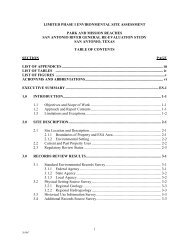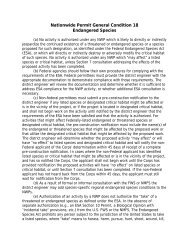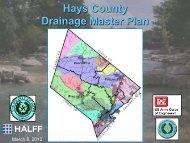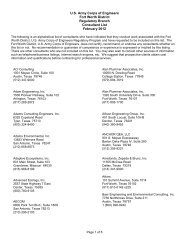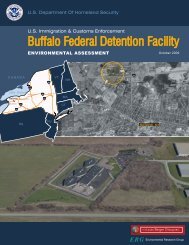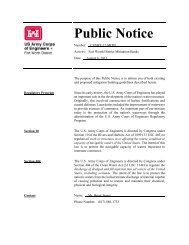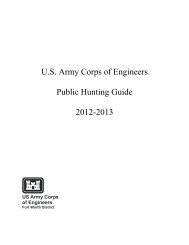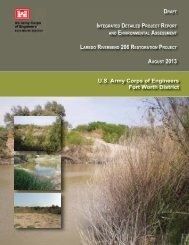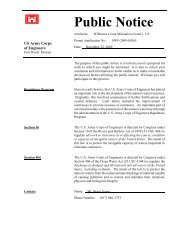environmental assessment us border patrol, tucson sector
environmental assessment us border patrol, tucson sector
environmental assessment us border patrol, tucson sector
You also want an ePaper? Increase the reach of your titles
YUMPU automatically turns print PDFs into web optimized ePapers that Google loves.
3-15123456789101112131415161718192021222324252627282930313233343536373839404142434445461975). Hares and rabbits commonly seen in the project area include black-tailed jackrabbit(Lep<strong>us</strong> californic<strong>us</strong>) and desert cottontail (Sylvilag<strong>us</strong> auduboni) (Findley et al. 1975).Birds typically associated with Chihuahuan desertscrub that are expected to occur in the projectarea include red-tailed hawk (Buteo jamaicensis), Swainson’s hawk (Buteo swainsoni),American kestrel (Falco sparveri<strong>us</strong>), Gambel’s quail (Callipepla gambelii), scaled quail(Callipepla squamata), western burrowing owl (Athene cunicularia), Chihuahuan raven (Corv<strong>us</strong>cryptoleuc<strong>us</strong>), loggerhead shrike (Lani<strong>us</strong> ludovician<strong>us</strong>), greater roadrunner (Geocoxxyxcalifornian<strong>us</strong>), cact<strong>us</strong> wren (Campylorhynch<strong>us</strong> brunneicapill<strong>us</strong>), great-tailed grackle (Quiscal<strong>us</strong>mexican<strong>us</strong>), and numero<strong>us</strong> passerine species (Peterson and Zimmer 1998).A wide variety of reptiles and amphibians can be found associated with Chihuahuan desertscrub.Many common species of amphibians could be found in the project area, including spadefoottoads (Scaphiop<strong>us</strong> spp.) and the western spadefoot toad (Spea multiplicata). Common reptilesinclude many lizard species, such as whiptail lizard (Aspidoscelis spp.), side-blotched lizard (Utastansburiana), greater earless lizard (Cophosaur<strong>us</strong> texan<strong>us</strong>), round-tailed horned lizard(Phrynosoma modestum), ornate tree lizard (Urosaur<strong>us</strong> ornata), and several species of spinylizard (Scelopor<strong>us</strong> spp.). Approximately 36 species of snakes have been known to occur near orwithin the project area. These snakes include western diamondback rattlesnake (Crotal<strong>us</strong> atrox),prairie rattlesnake (Crotal<strong>us</strong> viridis), glossy snake (Arizona elegans), Sonoran gopher snake(Pituophis melanoleuc<strong>us</strong>), Trans-Pecos ratsnake (Bogertophis subocularis), western groundsnake (Sonora semiannulata), and night snake (Hypsiglena torquata). The most common turtlefound in the Chihuahuan desertscrub is the desert box turtle (Terrepene ornate luteola) (Stebbins2003).3.6.1.1 Preferred AlternativeWildlife species observed at the Preferred Alternative site during the May 4, 2011 surveyincluded common raven (Corv<strong>us</strong> corax), canyon towhee (Pipilo f<strong>us</strong>c<strong>us</strong>), red-tailed hawk, blackthroatedsparrow (Amphispiza bilineata), tiger whiptail lizard (Aspidoscelis tigris), and elegantearless lizard (Holbrookia elegans).3.6.1.2 Alternative 2Animal species noted during the Alternative 2 site visit included black-tailed jack rabbit, blackthroatedsparrow, canyon towhee, tiger whiptail lizard, and elegant earless lizard. Several badgerburrows were also observed at the Alternative 2 site.3.6.1.3 Alternative 3Wildlife observed during the Alternative 3 site biological survey included black-tailed jackrabbit, canyon towhee, common raven, tiger whiptail lizard, and elegant earless lizard.3.6.1.4 Alternative 4A biological survey of the Alternative 4 site was conducted on May 5, 2011. Several birds wereobserved during the biological survey in and adjacent to the site, and included red-tailed hawk,red-winged blackbird (Agelai<strong>us</strong> phoenice<strong>us</strong>), black-throated sparrow, mourning dove (Zenaidamacroura), white-winged dove (Zenaida asiatica), common raven, canyon towhee, Harris’shawk (Parabuteo unicinct<strong>us</strong>), Gambel’s quail, turkey vulture (Cathartes aura), cliff swallow(Petrochelidon pyrrhonota), and canyon wren (Catherpes mexican<strong>us</strong>). A stick-built, raptor nestDouglas FOB EADraftAug<strong>us</strong>t 2011



